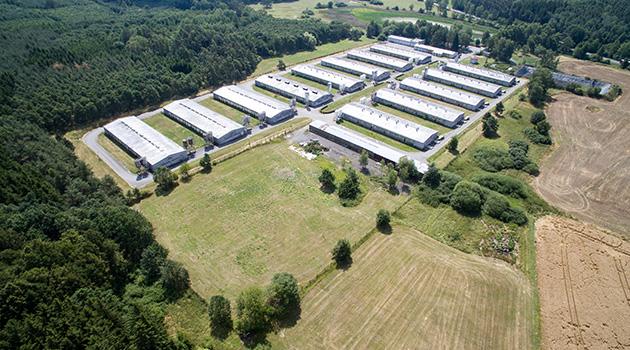Czech Republic's Museum of Romani Culture announces competition to design the memorial at the site of the former concentration camp for Romani people at Lety

Yesterday the Museum of Romani Culture announced the architectural and landscaping competition to design the Memorial to the Holocaust of the Roma at Lety in the Písek district, where a concentration camp for Romani people was in operation during the Second World War. The winner of the competition should be known in May of next year, director Jana Horváthová told journalists.
The process of demolishing the buildings that housed the now-defunct pig farm that was built on top of the former concentration camp in the 1970s will depend on the competition results. The museum wants to open the memorial in 2023.
The commission of the competition was designed in collaboration with experts from the fields of history, architecture, museum studies and Romani studies, as well as with eyewitnesses to the running of the concentration camp, survivors of the concentration camp and relatives of the victims. A publication will be issued about the competition including the full wording of the commission.
A new website has been launched, www.novypamatniklety.cz, where the conditions of the contest will be made available along with all of the background materials for it – information about the course of the competition will gradually be published there. The contest will have two rounds and is international – anybody from anywhere in the world can submit a proposal to it by 17 January 2020, according to Petr Návrat from the ONplan company, which is aiding the Museum with the competition.
The adjacent landscaping as well as the form of the memorial itself are meant to be designed through the competition process. According to ONplan, seven designs will be chosen during the first round, with the winner chosen by a jury comprised of experts and relatives of concentration camp victims during April and May of next year.
The demolition of the buildings of the now-defunct pig farm, for which the Czech state will make about CZK 110 million [EUR 4.3 million] available, will depend on the competition results. The process of the demolition will also involve re-cultivating the environment to prepare it for subsequent building there.
The memorial itself is meant to begin construction most probably after 2021. More than CZK 30 million [EUR 1.2 million] has been allocated for the first building phase and more than CZK 7 million [EUR 270 000] has been allocated to equip the memorial facility.
Some funding for the project has been awarded to the museum by Norway Grants. One component of the Memorial to the Holocaust of the Roma and Sinti in Bohemia will be an exhibition.
The commission of the architectural and landscaping competition is comprised of three main parts. The first part is the theme of the memorial, which has been co-authored by Helena Sadílková, the head of the Romani Studies Seminar at the Central European Studies Department of Charles University.
The second part is the memorial’s mission, which is comprised of four main points. “The memorial will have four main missions: Honoring the memory of the victims, informing visitors about what happened there, educating schoolchildren about the Holocaust of the Roma, and galvanizing discussion,” the museum director said.
The third, educational part comprises the basic thesis of the commission for the design of the memorial, which must take into consideration legally-binding design requirements, these basic ideas about the memorial’s theme and mission, and the program for building it. A jury comprised of experts and relatives of victims of the concentration camp will decide the final winner.
The core jury members are Museum of Romani Culture director Jana Horváthová, Czech Culture Ministry representative Martin Martínek, and the chair of the Committee for the Redress of the Roma Holocaust in the Czech Republic, Čeněk Růžička. Josef Pleskot, one of the Czech Republic’s most important contemporary architects, will also decide the winner of the competition as an independent jury member.
Emilia Rigová, an artist and university educator, will also sit on the jury. The expert part of the jury includes Pavel Vařeka, the head of the Archaeology Department at the University of Western Bohemia at Plzeň, who has been leading the archaeological survey at Lety that has been underway for several years now; Helena Sadílková; Jan Hauer and Antonín Lagryn.
The site of the former concentration camp at Lety was used for an industrial pig farm by the Communist regime in the 1970s. The farm began to be built in 1972 and was 7.1 hectares in area.
The Czech state then sold the facility to the AGPI firm in the 1990s. A total of 13 000 pigs could be raised for slaughter in 13 feed halls there.
Last year the Czech state bought the farm for CZK 372 574 380 [EUR 14,424,117.51], not including VAT. An archaeological survey of the location has recently been completed and ascertained that most of the former concentration camp for Romani people was indeed built over by the now-defunct pig farm facility.
The archaeologists also found unmarked burial sites of individuals near the former concentration camp at the location of the current Lety Cultural Heritage Memorial and uncovered a grave with the remains of a female prisoner as well as the final resting place of a newborn. Historians have documented that from August of 1942 until its closure in May 1943, as many as 1 308 Romani children, men and women passed through the concentration camp at Lety, at least 327 of whom died there and more than 500 of whom were forcibly relocated from Lety to the death camp at Auschwitz.
Approximately just 600 Romani people are said to have returned to Bohemia and Moravia from the concentration camps after the Second World War. Experts have concluded that the Nazis murdered 90 % of the Romani people indigenous to Bohemia and Moravia.
